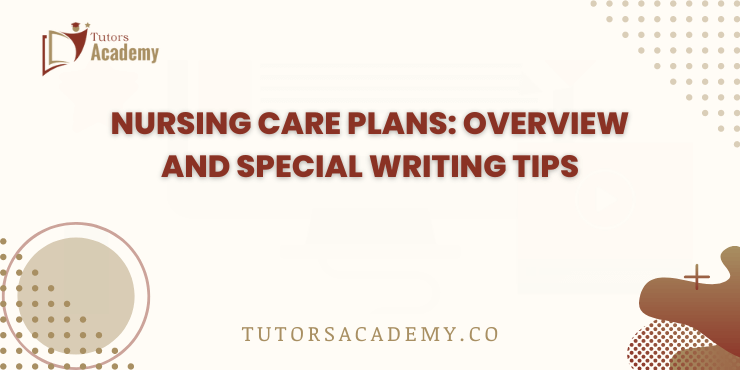
Introduction
A nursing care plan is a written plan about the care procedure for the patient. It has all the necessary information about the patient. The information includes the description of the treatment and checkup evaluation according to the patient’s health condition along with health problem diagnosis. Tutors Academy is a professional platform that helps nursing students in every matter of their lives. A nursing care plan helps in the good, organized, and flawless care of patients. This comprehensive guide provides a brief overview of the nursing care plans. It also discusses the important ways of writing nursing care plans. Nowadays, they are often computerized in the form of ready-to-use printed documents.
Description of a nursing care plan
The nursing care plans convey all the essential information about the patients with their disease history and present state of health. It helps the nurses to know more about their patients along with necessary health facilities and care. It serves as a set of guidelines for nurses to deal with their patients. It also helps the nurses to keep sequential information about the progress of their patients.
What are the types of nursing care plans?
There are varieties of nursing care plans. The most used types of nursing care plans are given below:
Informal nursing care plans: These are informal plans created by the nurses themselves. They help them remember their patients’ health history and the present and future strategies for the betterment of their health. They are only in the minds of nurses and are not well documented. The nurses do not have to share these plans with others. It shows their creativity and professionalism to handle all types of problems quickly.
Formal nursing care plans: These plans are in well-written and computerized form. They provide the patient’s health history concisely and clearly. They are official files that circulate between the patient, nurses, and senior medical doctors. They are very useful for medical staff in complex and critical health situations. They can be updated easily.
Standardized nursing care plans: These care plans are officially prepared by healthcare organizations. They already have special guidelines for specific patients. They contain well-structured portions for patient conditions, diagnosis of health issues, and cure for the disease. They represent high-quality health services for the patients. The portions of the health care plan can be changed according to the requirements of the patients.
Individualized nursing care plans: These are plans created by healthcare professionals for each patient according to their different health histories. They are updated according to the health care preferences of the patient. They are centered on a specific patient. These plans are made for the most deserving patients. These care plans help in better care and service for the sake of these patients.
Important tips for writing a nursing care plan?
A nursing care plan is a concise history of a patient’s ailments having a cure. It shows the whole process of treatment for the patient. It is very beneficial for patients admitted to intensive care units in critical conditions. There are five steps to writing a successful nursing care plan.
Five steps of writing a professional nursing care plan
The successful process of writing a nursing care plan has five steps. They are the collection of data, health problem diagnosis, goals, implementation of care plans, and results evaluation.
Collection of data: In the first step, a nurse collects subjective and objective data about the patient. The data that is provided by the patient having feelings, concerns, and symptoms is called subjective data. On the other hand, the observations made by the nurses in the form of laboratory results, important signs, and physical symptoms are known as objective data. For example, if the patient tells about his medical history, medications, and self-care abilities, then the nurse collects subjective data. If the nurse notes down the measurement of a patient’s blood glucose, blood pressure, and health condition, then she collects objective data.
Health problem diagnosis: In the second step, the nurse analyzes the health issue of the patient. The problem is identified along with cures and medications. This is known as the process of nursing diagnosis.
Setting the Objectives: In the third step, the nurse determines the objectives of her services. The main aim of the nurse’s goals for his patient is within a limited time frame. These objectives are determined by following the SMART method. SMART stands for specific, measurable, achievable, relevant, and time-bound.
Implement the Healthcare Plans: In the fourth step, the healthcare plans are implemented to achieve the objectives of the treatment of the patient.
Analysis of the Results: In the fifth and final step, the nurse checks the results by checking the recovery status and present condition of the patient. If the results are good and satisfactory, then the patient is discharged from the hospital.
How to write an excellent care plan for nursing
- Use a nursing care plan that is most suitable for you.
- Use clear and concise language.
- Avoid jargon or abbreviations.
- Use relevant sources of evidence.
- Involve the patient in the healing process and respect his feelings.
- Encourage cooperation to create a flawless care plan.
- Update the care plan regularly according to the patient’s condition.
- Do critical thinking to add your points in the ready-to-use care plan.
- Focus on extensive care for improvement in the health of the patient.
Different ready-to-use forms of nursing care plans
A nursing care plan is essential for high-quality healthcare services. Tutors Academy is guiding high-quality nursing care plans to nursing students. They are very beneficial for nursing students. Nursing students all over the world have direct access to these high-scoring templates. Nursing care plan formats and templates have four columns including nursing diagnoses, outcomes and goals, nursing interventions, and evaluation. Some organizations have a three-column plan with goals and evaluation in the same column. There are different advantages and disadvantages to different formats and templates. Nurses must know about the purpose of nursing care plans according to the complexity of the patient’s health. Some of the common ready-to-use forms for nursing care plans are:
Narrative form: It uses paragraphs and sentences to describe the parts of the care plan. It is comprehensive and flexible. It is time-consuming and difficult to read and update.
List form: It includes bullet points and keywords. It helps summarize the components of the care plan. It is concise and easy to update. It is easy to read.
Table form: It includes rows and columns to organize the components of the care plan. It is well-structured and clear.
Concept map form: It includes concept maps to explain the relationships between the different parts of the care plan. This format is visual and creative. It is easily understandable.
Electronic medical records (EMRs) for making electronic nursing care plans Electronic medical records (EMRs) are digital versions of paper charts. They have the medical history of the patients. EMRs can help nurses to generate nursing care plans easily. It provides the data in the form of evidence about diagnostic and laboratory tests. It includes the standardized usage of terminologies, such as NANDA-I, NIC, and NOC. They are easy to use according to the patient’s requirements.

Tutors Academy provides free samples for nursing care plan assessments
NURS FPX 4050 Assessment 4: Final care coordination plan
Tutors Academy offers free samples for this assessment. It is a course at Capella University. The course of NURS FPX 4050 focuses on patient-centered care. The course includes important topics like high-quality healthcare services and care policy factors. It also focuses on the powerful role of communication and collaboration in the patient’s healing process. The plan includes an analysis of the patient’s health issues. Then it moves towards interventions and evaluation of the best practices.
NURS FPX 4050 Assessment 2: Ethical and policy factors in care coordination
Many high-scoring samples of these assessments are available on the website of the world’s most renowned academic assistance platform named, Tutors Academy. In NURS FPX 4050, nursing students have to make a presentation on the factors of care coordination. The presentation gives an overview of the government policies. It includes a discussion about these policies. It raises some ethical dilemmas during care coordination. It also explains the nursing code of ethics. It also tells about the present policies and accepted standards of practice that influence care coordination.
The NURS FPX 4050 Assessment 1: Preliminary care coordination plan
Tutors Academy provides excellent nursing assessments. The NURS FPX 4050 Assessment 1 Preliminary Care Coordination Plan is an assignment of the course named Care Coordination. It is offered by Capella University. The purpose of this assessment is to train the students in making a flawless nursing care plan. They are guided about the types of problems faced by the patients and the ways of handling them through proper planning and decision-making. The assignment demands the students to analyze the problem and give the best care plan for the health improvement. It enables them to create goals for curing health issues. The students have to identify the resources for good service and care.
Important examples of an ideal nursing care plan
A nursing care plan is an essential tool for delivering high-quality health care service.
Important examples of nursing care plans for different cases of the patient
There are various types of nursing care plans according to the patient scenarios and diagnoses. Some examples are given below:
Nursing plan for head Injury due to substance abuse
This is an example of the case of a patient having an accidental head injury due to substance abuse. The important points of this nursing care plan are given below:
Diagnosis: Accidental injury due to low consciousness and impaired judgment. It has been observed by a positive urine drug screen and Glasgow Coma Scale score of 12.
Results: The patient healed his injury. There were no complications during hospitalization.
Nursing interventions and rationales: Monitor the patient and record the condition of the patient. The neurological condition is examined through the Glasgow Coma Scale score after every 2 hours. It will tell about the recovery of the severe head injury and the additional effects of substance abuse. Oxygen therapy will be administered as required. It will prevent hypoxia in the patient. A safe and quiet environment is provided for the patient.
Evaluation: There were no new injuries or problems observed in the patient during the hospitalization phase. The patient and family were very cooperative against substance abuse. The patient took a rehabilitation course for quick recovery.
Nursing care plan for a kidney patient
Diagnosis: Excess urea in blood and decreased urine output. Dysfunctional urinary system along with edema, dyspnea, crackles, and weight gain.
Results: The urea was removed from the blood of the patient through dialysis.
Nursing care methodologies: Monitor and record urine output, weight, and fluid level. Restrict the intake of fluids and sodium. Avoid excessive fluid and sodium intake. It will prevent excessive urea in the blood. It will also prevent the imbalance of electrolytes in the human body.
Evaluation: The patient has done strict dieting to remove urea from the blood. The patient and family cooperated strongly with the medical team for better functioning of the kidneys.
How to update nursing care plans according to the status of the patient?
Nursing care plans are not written only once. They can be changed continuously. They are flexible as well. They are changed according to the condition of the patient. Following are some important points for changing the nursing care plans:
- Continuously update the nursing care plan for the patient’s fast recovery. For example, if the patient can get better through exercise along with medications. Then include exercise routine in the nursing care plan.
- Create a flexible and easy-to-follow care plan by cooperating with the patients. For example, a nurse creates a flexible care plan for a patient with a fractured leg through physical therapy sessions for added cooperation and quick recovery.
Conclusion
In conclusion, it is concluded that Tutors Academy is a leading platform for helping nursing students all over the world. It has been helping nursing students for decades. It is an important part of the nursing process and practice. This comprehensive guide has deeply explained the types of nursing care plans. It teaches nursing students about the ways of writing an exceptional nursing care plan that is acceptable in professional settings. This guide discusses the components of a perfect nursing care plan. It also discusses the nursing care plans through the help of examples from health-related issues. There are different formats and templates of nursing care plans. The most prominently used plan is the electronic nursing care plan. It guarantees accurate records of every patient and high-quality nursing service in return. It helps the nurses in providing high-quality healthcare services to the patients. The patients must receive the best possible care.
FAQ's
Yes! We have many high-scoring assessment samples for the assessment of the “Final Care Coordination Plan”.
Yes! We have many free and high-scoring samples for the assessment named,” Ethical and Policy Factors in Care Coordination”.
Yes! Absolutely. We are offering high-scoring assessment samples on the NURSE FPX 4050 Assessment 1 Preliminary Care Coordination Plan.
A well-structured outline shows your organized thoughts. It creates a logical flow in your nursing assignment. An effective outline acts as a roadmap. It will guide you about the writing process. A well structured assignment must cover all the necessary points.
Yes! Our nursing professionals will help you in writing high-scoring nursing assignments.
Yes! Absolutely. We are offering free samples for the RN-BSN nursing degrees.
The correct way of writing a nursing care plan includes five steps. They are assessment, diagnosis, outcomes, implementation, and evaluation.
Yes! Absolutely. Nursing students can get free nursing assessment samples from the Tutors Academy.
